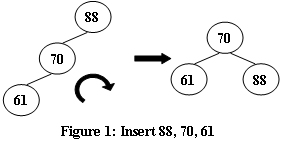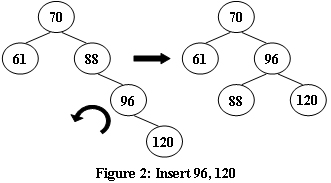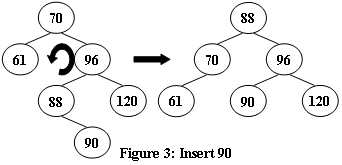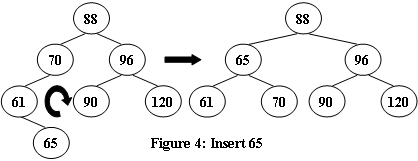1066 Root of AVL Tree (25 分)
An AVL tree is a self-balancing binary search tree. In an AVL tree, the heights of the two child subtrees of any node differ by at most one; if at any time they differ by more than one, rebalancing is done to restore this property. Figures 1-4 illustrate the rotation rules.



Input Specification:
Each input file contains one test case. For each case, the first line contains a positive integer N (≤) which is the total number of keys to be inserted. Then N distinct integer keys are given in the next line. All the numbers in a line are separated by a space.
Output Specification:
For each test case, print the root of the resulting AVL tree in one line.
Sample Input 1:
5
88 70 61 96 120
Sample Output 1:
70
Sample Input 2:
7
88 70 61 96 120 90 65
Sample Output 2:
88
前面学完AVL这题就是板子题了。
只要插入就行,然后输出根节点。
1 #include <iostream> 2 #include <cmath> 3 #include <vector> 4 #include <algorithm> 5 #include <queue> 6 using namespace std; 7 struct Node { 8 int val; 9 Node *left, *right; 10 } *tree; 11 int n, m; 12 13 Node *leftrotate(Node * tree) { 14 Node *temp = tree->left; 15 tree->left = temp->right; 16 temp->right = tree; 17 return temp; 18 } 19 20 Node *rightrotate(Node * tree) { 21 Node *temp = tree->right; 22 tree->right = temp->left; 23 temp->left = tree; 24 return temp; 25 } 26 27 Node *rightleftrotate(Node * tree) { 28 tree->left = rightrotate(tree->left); 29 return leftrotate(tree); 30 } 31 32 Node *leftrightrotate(Node * tree) { 33 tree->right = leftrotate(tree->right); 34 return rightrotate(tree); 35 } 36 37 int getlen(Node * root) { 38 if (root == NULL) 39 return 0; 40 return max(getlen(root->left), getlen(root->right)) + 1; 41 } 42 Node *insert(Node * tree, int val) { 43 if (tree == NULL) { 44 tree = new Node(); 45 tree->val = val; 46 } else if (val < tree->val) { 47 tree->left = insert(tree->left, val); 48 int ll = getlen(tree->left), rr = getlen(tree->right); 49 if (ll - rr >= 2) { 50 if (val < tree->left->val) 51 tree = leftrotate(tree); 52 else 53 tree = rightleftrotate(tree); 54 } 55 } else if (val > tree->val) { 56 tree->right = insert(tree->right, val); 57 int ll = getlen(tree->left), rr = getlen(tree->right); 58 if (rr - ll >= 2) { 59 if (val > tree->right->val) 60 tree = rightrotate(tree); 61 else 62 tree = leftrightrotate(tree); 63 } 64 } 65 return tree; 66 } 67 vector<int> v, vt; 68 void output(Node *root, int x){ 69 if(root != NULL){ 70 output(root->left, x<<1); 71 //cout <<root->val<<endl; 72 output(root->right, (x<<1)+1); 73 }else{ 74 v.push_back(x); 75 } 76 } 77 78 int main() { 79 cin >> n; 80 for (int i = 0; i < n; i++) { 81 cin >> m; 82 tree = insert(tree, m); 83 } 84 cout << tree->val << endl; 85 return 0; 86 }
